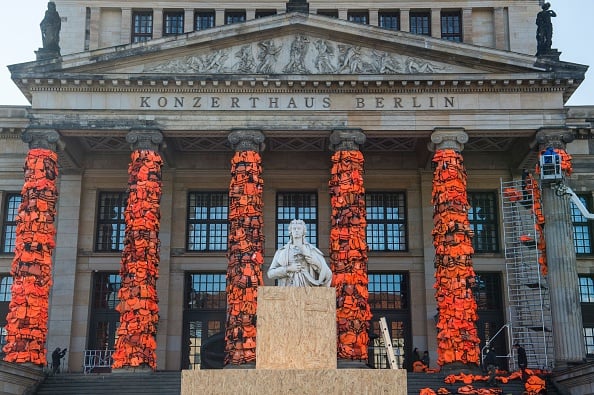People
Ai Weiwei Commemorates Drowned Refugees with Public Installation during Berlin Film Festival
But is he missing the point?

But is he missing the point?

Henri Neuendorf

Seemingly undisturbed by the huge backlash caused by his recreation of the tragic image of the the drowned three-year-old Syrian refugee Alan Kurdi, in his latest public artwork Chinese artist and activist Ai Weiwei has returned to the subject and attached 14,000 life jackets used by refugees to Berlin’s Konzerthaus concert hall.
The fluorescent orange vests, which are tightly wrapped around the columns of the 19th century music venue, were collected by the artist on his frequent recent trips to the Greek island of Lesbos, where hundreds of refugees land every day after completing the treacherous sea journey from Turkey.
According to the Der Standard, the installation is a tribute to the refugees that died at sea in an attempt to escape war and poverty in the Middle East and North Africa.
Berlin is currently halfway through the annual Berlinale film festival, which attracts Hollywood stars and major film industry figures to the German capital. The intervention at the Konzerthaus was installed to coincide with the Cinema for Peace gala, which takes place at the venue tonight.
The calculating and media-savvy artist doubtlessly chose the timing deliberately to maximize media exposure of his project, coinciding with a time when the attention of the international press is focused on Berlin and its film festival.
But not everyone has celebrated the installation. Commenting on the Der Standard article, one reader said: “It would have been more useful to send and distribute them [the life jackets] in north Africa.” Another reader wrote: “Art is in the eye of the beholder.”
The choice of place is certainly perplexing. Staging an installation of this nature in Germany is somewhat akin to preaching to the choir. According to the New York Times, Germany took in over 1 million refugees last year, more than any other European Union member state.
Moreover, the Konzerthaus is located at Berlin’s Gendarmenmarkt, the focal point of the Huguenot population that fled religious persecution in Catholic France in the 17th century and was granted refuge in Berlin by Frederick the Great in 1685. According to Berlin.de, about 20,000 Huguenots emigrated to Berlin and, at the start of the 18th century, it was estimated that 1 in 5 Berliners were of Huguenot origin.
In other words, Ai’s installation—while retaining critical undertones—is located in the center of what has been a symbol of Germany’s tolerance and embrace of refugees since the 17th century.
Why not stage the installation in countries that have taken in few, or no refugees? The UK, the US, or Hungary are just three examples of places where Ai’s important message would be far more evocative.
The message is important, however the ill-placement leaves the bitter aftertaste that Ai’s intention is not to raise awareness and draw attention to the plight of refugees, but rather to draw attention to himself.